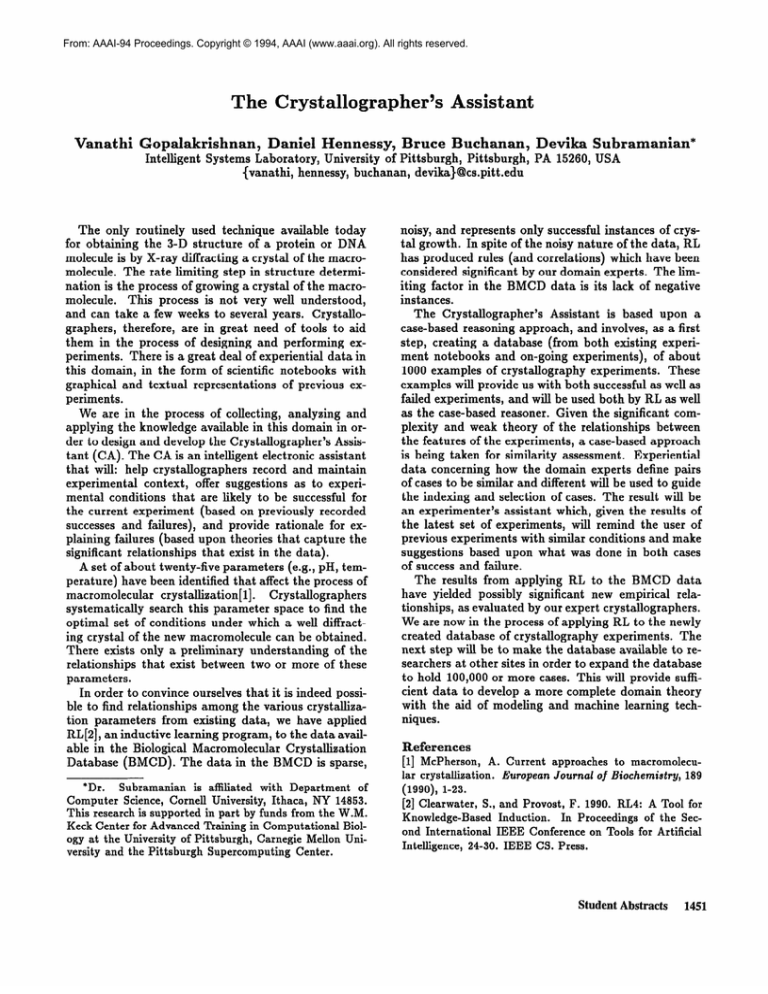
From: AAAI-94 Proceedings. Copyright © 1994, AAAI (www.aaai.org). All rights reserved.
The Crystallographer’s
Vanathi
Gopalakrishnan,
Intelligent
Daniel Hennessy,
Assistant
Bruce Buchanan,
Systems Laboratory, University of Pittsburgh, Pittsburgh,
(vanathi, hennessy, buchanan, devika}Qcs.pitt.edu
The only routinely used technique available today
for obtaining the 3-D structure of a protein or DNA
molecule is by X-ray diffracting a crystal of the macromolecule. The rate limiting step in structure determination is the process of growing a crystal of the macromolecule.
This process is not very well understood,
and can take a few weeks to several years. Crystallographers, therefore, are in great need of tools to aid
them in the process of designing and performing experiments. There is a great deal of experiential data in
this domain, in the form of scientific notebooks with
graphical and textual representations of previous experiments.
We are in the process of collecting, analyzing and
applying the knowledge available in this domain in order to design and develop the Crystallographer’s
Assistant (CA). The CA is an intelligent electronic assistant
that will: help crystallographers
record and maintain
experimental
context, offer suggestions as to experimental conditions that are likely to be successful for
the current experiment (based on previously recorded
successes and failures), and provide rationale for explaining failures (based upon theories that capture the
significant relationships that exist in the data).
A set of about twenty-five parameters (e.g., pH, temperature) have been identified that affect the process of
macromolecular
crystallization[l].
Crystallographers
systematically
search this parameter space to find the
optimal set of conditions under which a well diffracting crystal of the new macromolecule can be obtained.
There exists only a preliminary understanding
of the
relationships that exist between two or more of these
parameters.
In order to convince ourselves that it is indeed possible to find relationships among the various crystallization parameters from existing data, we have applied
RL[2], an inductive learning program, to the data available in the Biological Macromolecular
Crystallization
Database (BMCD). The data in the BMCD is sparse,
Subramanian is affiliated with Department of
Computer Science, Cornell University, Ithaca, NY 14853.
This research is supported in part by funds from the W.M.
*Dr.
Keck Center for Advanced Training in Computational
Biology at the University
of Pittsburgh,
Carnegie Mellon University and the Pittsburgh
Supercomputing
Center.
Devika Subramanian*
PA 15260, USA
noisy, and represents only successful instances of crystal growth. In spite of the noisy nature of the data, RL
has produced rules (and correlations) which have been
considered significant by our domain experts. The limiting factor in the BMCD data is its lack of negative
instances.
The Crystallographer’s
Assistant is based upon a
case-based reasoning approach, and involves, as a first
step, creating a database (from both existing experiment notebooks and on-going experiments),
of about
1000 examples of crystallography
experiments.
These
examples will provide us with both successful as well as
failed experiments, and will be used both by RL as well
as the case-based reasoner. Given the significant complexity and weak theory of the relationships between
the features of the experiments, a case-based approach
is being taken for similarity assessment. Experiential
data concerning how the domain experts define pairs
of cases to be similar and different will be used to guide
the indexing and selection of cases. The result will be
an experimenter’s assistant which, given the results of
the latest set of experiments, will remind the user of
previous experiments with similar conditions and make
suggestions based upon what was done in both cases
of success and failure.
The results from applying RL to the BMCD data
have yielded possibly significant new empirical relationships, as evaluated by our expert crystallographers.
We are now in the process of applying RL to the newly
created database of crystallography
experiments. The
next step will be to make the database available to researchers at other sites in order to expand the database
to hold 100,000 or more cases. This will provide sufficient data to develop a more complete domain theory
with the aid of modeling and machine learning techniques .
eferences
[l]
McPherson,
A.
lar crystallization.
Current
approaches
to macromolecu-
European Journal of Biochedstry,
189
(1990), l-23.
[2] Clearwater,
S., and Provost,
Knowledge-Based
Induction.
ond International
IEEE
Intelligence,
24-30.
IEEE
F.
1990.
RL4:
In Proceedings
Conference
on Tools
A Tool for
of the Secfor Artificial
CS. Press.
Student Abstracts
1451
